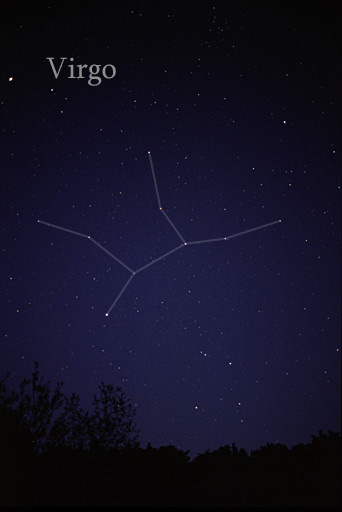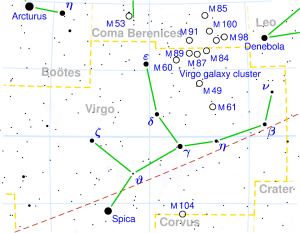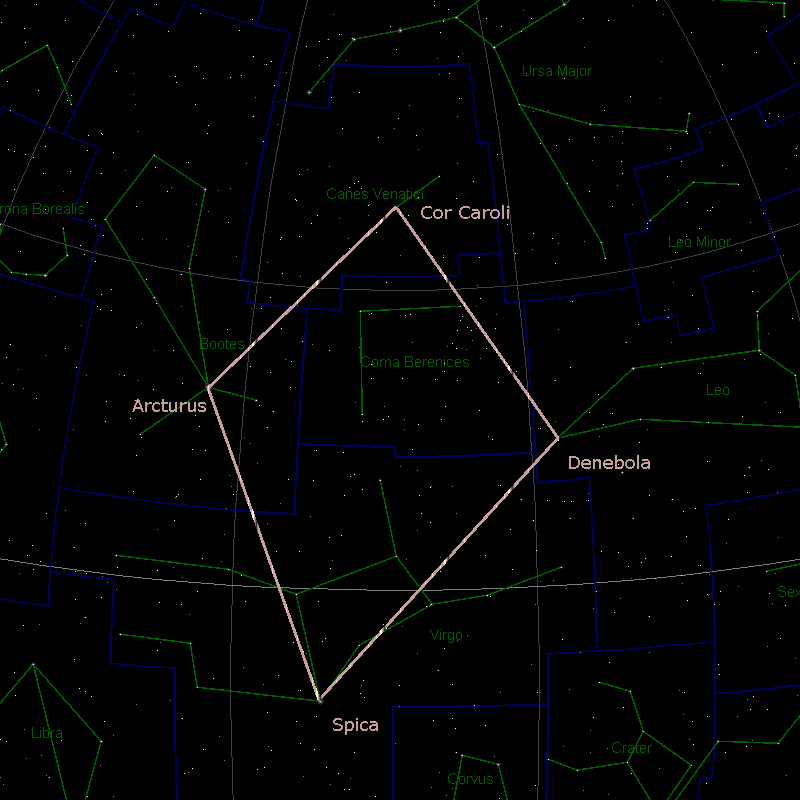Spica, Alpha Virginis, is the brightest star in the southern constellation Virgo and the 16th brightest star in the sky.
It is a blue subgiant star located at a distance of 250 light years from Earth. Spica is really a close binary star system. It is one of the nearest massive binary stars to the solar system.
The name Spica (pronounced /ˈspaɪkə/) comes from the Latin phrase spīca virginis, meaning “Virgo’s ear of grain.” The Latin word spicum refers to the ear of wheat Virgo holds in her left hand. In Greek and Roman mythology, the constellation and the star were associated with Demeter (Ceres), the goddess of the harvest.
Spica is bright both because of its size and its relative proximity to Earth. The components in the system have a radius 7.40 and 3.64 times that of the Sun. Both stars are significantly brighter than the Sun, with total luminosities (including ultraviolet radiation) of 12,100 and 1,500 times solar. Spica A and Spica B both belong to the spectral class B, which makes them bluish-white in colour.
The stars are also much hotter than the Sun, with estimated surface temperatures of 22,400 K and 18,500 K, compared to the Sun’s 5,800 K. This makes Spica one of the hottest first magnitude stars.
The primary star in the system is halfway between a subgiant and giant on the evolutionary scale. It belongs to the spectral class B1 III-IV. With a mass more than 10 times that of the Sun, Spica A is one of the nearest stars to Earth that are massive enough to end their life in a Type II supernova event. The primary component is responsible for about 80 percent of the light that comes from the star system.
Spica is classified as a Beta Cephei variable. It exhibits variations in brightness over a 0.1738-day period. The star is a very fast spinner, with a projected rotational velocity of 199 km/s at the equator.
The two components in the Spica star system are so close together – only 0.12 astronomical units apart – that they complete an orbit around each other every four days, and can’t be resolved in a telescope. The star’s binary nature wasn’t discovered until its light was analyzed with a spectroscope.
The stars in the Spica system orbit a common centre of mass (barycentre) at about 56 miles per second at a distance of only 18 million kilometres, or 11 million miles, compared to 150 million kilometres for Earth’s distance to the Sun. As a result of their proximity, the gravity distorts both stars into an egg-like shape, with their pointed ends facing each other. The stars’ shapes can’t be seen directly, not even in a telescope, but slight changes in magnitude may be evidence that they are distorted by the interaction.
The system is classified as a double-lined spectroscopic binary, showing a Doppler shift in the absorption lines of the stars’ spectra resulting from the changes in the star system’s orbital motion.
The variations in Spica’s magnitude are likely the result of the two stars showing more or less surface area as they orbit each other. The stars have different orientations during different phases of their orbits and, as they are distorted in shape, their apparent diameter changes over the course of an orbit.
Spica is a rotating ellipsoidal variable, which means that the two stars in the system are distorted by their gravitational interaction. The system is a non-eclipsing binary, with neither star passing in front of the other from our point of view. Spica exhibits variations in magnitude of 0.03 over a period matching the stars’ orbital period.
Spica B, the secondary member of the star system, belongs to the spectral class B2 V, which means that it is still on the main sequence. It is smaller and less massive than the main component, with only 7 solar masses.
The secondary component provides a rare example of the Struve-Sahade effect, which means that the star’s spectral lines exhibit an anomalous change in strength over the course of an orbit, and become weaker as the star moves away from the observer. This may be the result of a strong stellar wind from Spica A scattering the light from the smaller star as the latter recedes.
The Alpha Virginis star system is a massive source of X-rays. At least some of the X-rays are believed to be produced by collisions of the stars’ stellar winds.
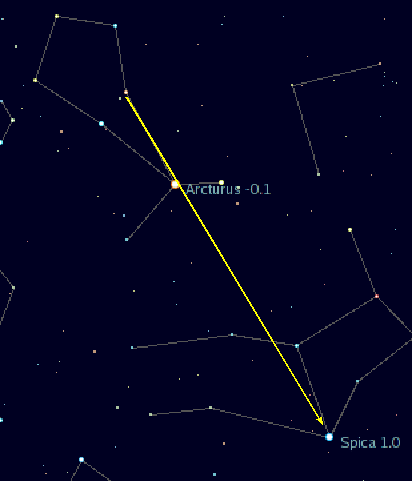
Diagram showing how to locate the star Spica using Arcturus as a guide. Drawn by Jim Thomas on 19 June, 2006.
Spica can be located by following the arc of the Big Dipper‘s handle, formed by the bright Alkaid, Mizar and Alioth. The first bright star along the imaginary line is Arcturus, the Bear Watcher, and following the same curving path, the second bright star that appears is Spica. The apparent distance from Arcturus to Spica is roughly equal to the distance between Arcturus and Alkaid, the star marking the tip of the Dipper’s handle.
The best time of year to observe Spica is from spring to late summer. The star emerges on the horizon in the east-southeast at sunset in mid-April and can be seen throughout the night. Spica can be found at its highest point to the south in the early evening about two months later. By late August, it can only be seen for a short period after sunset in the west-southwestern sky.
The Sun passes about 2 degrees north of the star every year around October 16. Spica’s heliacal rising occurs about two weeks after this date. Venus passes near the star every eight years around the same date.
Spica lies close to the ecliptic, roughly 10 degrees south of the celestial equator, and can be occulted by the Moon, sometimes even by planets. The last time it was occulted by a planet was on November 10, 1783, when Venus passed in front of it. The next planetary occultation, also by Venus, will occur on September 2197.
Based on observations during lunar occultations, when the star’s light is occulted by the Moon, some astronomers believe that there may be up to three more stars in the Spica system.
Facts
Together with the bright stars Arcturus in Boötes constellation, Denebola in Leo, and Cor Caroli in the constellation Canes Venatici, Spica forms an asterism known as the Diamond of Virgo, 50 degrees in extent.
Along with Regulus in Leo, Alpha Virginis is believed to be one of the bright stars that made it possible for Hipparchus (160 – 120 BC) to discover the precession of the equinoxes, after comparing his data to that of the Alexandrian Timochares, who had observed Spica and Regulus around 300 BC. Spica was later observed by Nicolaus Copernicus, who also used it to study precession.
Spica’s projected galactic orbit takes the star between 22,500 and 24,400 light years from the centre of the Milky Way. The star moves through the galaxy at a speed of 18.9 km/s relative to the Sun.
A temple to Menat at Thebes, constructed around 3200 BC, was oriented toward Spica. As a result of precession, the star’s position relative to the temple slowly changed over time.
A number of temples were oriented to Spica’s setting, including the temple of the Sun at Tell el-Amarna (2000 BC), two temples at Rhamnus in Greece (1092 and 747 BC), another two at Tegea, Hera’s temples at Olympia (1445 BC), Girgenti and Argos, the temple of Diana of the Ephesians (715 BC), and the temple of Nike Apteros at Athens (1130 BC). The temple orientation indicates that these cultures had knowledge of the precession of the equinoxes far earlier than Hipparchus documented his discovery.
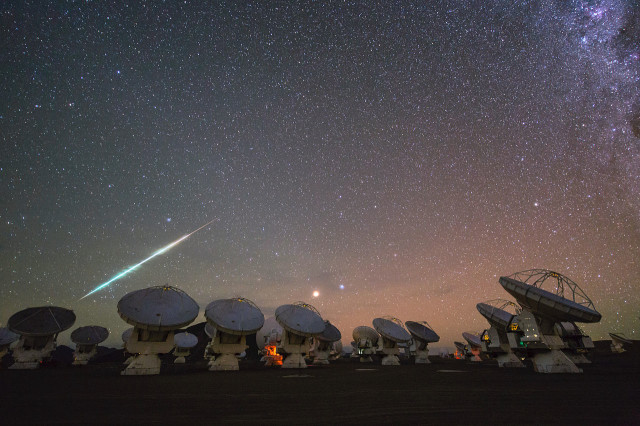
This beautiful new image, taken during a time lapse set at the Atacama Large Millimeter/submillimeter Array (ALMA) is another dramatic Ultra High Definition photograph from the ESO Ultra HD Expedition. ALMA, located at 5000 metres above sea level on the remote and empty Chajnantor Plateau in the Chilean Andes, marks the second destination for the four ESO Photo Ambassadors on their 17-day trip. The ambassadors are equipped with state-of-the-art Ultra HD tools to help them capture the true majesty of sights like the one pictured here. Some of the 66 high-precision antennas that comprise ALMA are visible here, with dishes pointed aloft, studying the cold clouds in interstellar space, and peering deep into the past at our mysterious cosmic origins. The spectacular javelin of light over the ALMA array is a falling star, slicing through the image in a vivid streak of colours. Emerald green, golden and faint crimson hues blaze brightly as the meteor burns up as it enters the Earth’s atmosphere and makes its fiery voyage across the sky. As the high-speed fireball — which is, in reality, a small grain of rock from interplanetary space — interacts with the atmosphere it heats up, vapourising the surface layers of the meteor, which are left behind in a glowing trail. These trails disappear in just a few seconds, but are captured here at the click of a button. The brightest star in the constellation of Virgo (The Virgin), known as Spica, and our neighbouring planet Mars glow brightly in the centre of the image — cosmic spectators to this fiery descent as they rise above the horizon. Image: ESO/C. Malin
In ancient Greece, Spica and Virgo constellation were associated with Demeter, and also with Dike, the goddess of justice, and Persephone, wife of Hades and daughter of Demeter.
Spica has been known by many different names across the cultures. The 17th century German astronomer Johann Bayer called the star Arista. In medieval times, the names for the star included Azimech and Alarph. Both were derived from Arabic; Azimech from al-simāk al-a‘zal, meaning “the undefended” or “the solitary one,” and Alarph, from the Arabic phrase meaning “the grape gatherer.” Spica’s other names included Sumbalet, meaning “the corn ear,” which is the Arabic name for the constellation Virgo, and also Sombalet, Shibbōleth, Sombalet, and Sembalet Eleandri.
Babylonian observers called the star Sa-Sha-Shirū, meaning “the virgin’s girdle.” The star represented the wife of Bel.
In China, Spica is known as Jiao Xiu 1 and belongs to the constellation Jiao Xiu. Ancient Chinese considered Spica to be a special star of spring and called it Kio, the Horn. Spica also marks the eye of the Dragon as it belongs to the first Chinese lunar mansion, which is the first sector for the Azure Dragon or the Dragon of the East, the guardian god of the eastern direction in their astrology. The major part of the dragon’s figure was formed by Scorpius constellation, with the bright Antares, known as the Fire Star, marking the dragon’s heart.
Egyptians identified Virgo with the goddess Isis, and saw the star Spica as the goddess’ lute bearer. They also knew the star by a different name, Repā, meaning “the lord.”
To Hindu observers, the star corresponds to the Nakshatra Chitra. They called the star Citrā, meaning “bright.”
Spica represents the Brazilian state of Pará on the Brazilian flag.
Spica – Alpha Virginis
Constellation: Virgo
Coordinates: 13h 25m 11.5793s (right ascension), -11°09’40.759” (declination)
Spectral class: B1 III-IV/B2 V
Distance: 250 light years (77 parsecs)
Apparent magnitude: 1.04
Absolute magnitude: -3.55 (-3.5, -1.5)
Orbital period: 4.0145898 days
Mass: 10.25 solar masses (Spica A), 6.97 (Spica B)
Radius: 7.40 solar radii (Spica A), 3.64 (Spica B)
Luminosity: 12,100 solar luminosities (Spica A), 1,500 (Spica B)
Temperature: 22,400 K (Spica A), 18,500 (Spica B)
Rotational velocity: 199 km/s (Spica A), 87 km/s (Spica B)
Variable type: Beta Cephei, rotating ellipsoid
Pronunciation: /ˈspaɪkə/
Designation: Spica, Alpha Virginis, α Virginis, 67 Virginis, Spica Virginis, HD 116658, HR 5056, SAO 157923, BD -10°3672, GCTP18144, HIP 65474, FK5 498, CCDM 13252-1109
